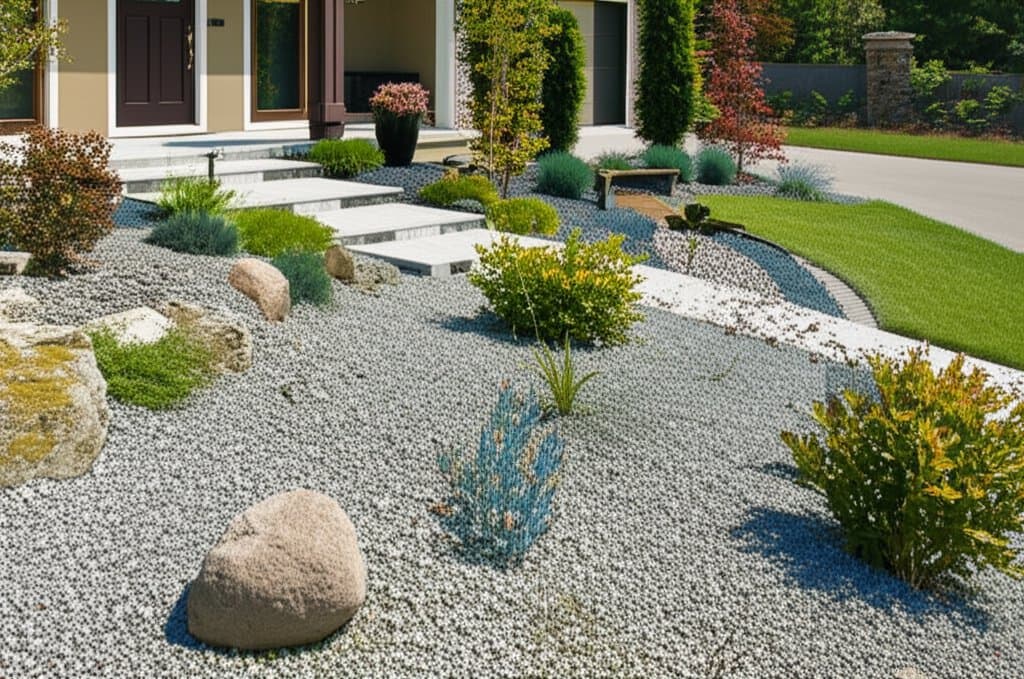Gravel Gardens: A Resilient Alternative to Traditional Lawns
Homeowners often face the challenge of maintaining lush grass that demands regular mowing, watering, and fertilizing, only to falter during hot, dry periods. Gravel gardens provide a compelling solution, delivering year-round visual interest with minimal effort. These landscapes withstand extreme weather, conserve resources, and require far less intervention than conventional turf. Before embarking on this transformation, consider the key elements that ensure long-term success.
Understanding Lawn Limitations and Gravel Garden Advantages
Traditional lawns depend on steady water supply, fertile soil, and ongoing care to remain vibrant. In regions prone to heat waves or water restrictions, grass browns rapidly and becomes susceptible to pests and diseases. Gravel gardens excel in these environments by incorporating a permeable surface that retains subsurface moisture while facilitating quick drainage during storms.
Essential Materials and Site Preparation
Select a sunny, well-drained spot to maximize plant health and gravel performance. Ideal candidates include front yards, side paths, or underutilized areas where grass struggles. Gather these core components:
- Durable weed barrier fabric, such as permeable geotextile, to block invasive roots without impeding water flow
- Varied gravel types, including pea gravel for a soft texture or decomposed granite for a rustic feel, sized 1/4 to 3/4 inch for optimal coverage
- Drought-resistant plants like lavender for fragrance, sedum for ground cover, yucca for architectural height, or feather reed grass for subtle movement
- Sturdy edging, such as galvanized steel or recycled plastic, to define borders and prevent gravel spread
Budget for materials typically ranges from $2 to $5 per square foot, depending on gravel quality and plant selections. Preparation may take one full weekend, with installation following shortly after, assuming familiarity with tools like shovels, rakes, and wheelbarrows.
Detailed Guide to Constructing a Durable Gravel Garden
Follow these steps to build a foundation that endures seasonal shifts.
-
Prepare the Site Thoroughly
Excavate existing sod, weeds, and roots to a depth of 4 to 6 inches. Rake the soil smooth and use a plate compactor or hand tamper to firm the base, ensuring even support for the gravel layer.
-
Lay the Weed Suppression Layer
Unroll the fabric over the prepared area, securing overlaps of 6 to 12 inches with metal staples every 2 feet. Trim excess material and extend the fabric slightly beyond planned edges for full protection.
-
Distribute the Gravel Evenly
Pour gravel in layers of 2 to 3 inches, raking it level with a landscape rake. For high-traffic zones, like walkways, add a second thin layer and compact it to enhance firmness and reduce shifting.
-
Incorporate Plants Thoughtfully
Snip precise X-shaped slits in the fabric for each planting hole, sized to accommodate root balls without excess soil exposure. Position drought-tolerant varieties according to their mature spread, allowing 18 to 36 inches between specimens to prevent overcrowding as they grow.
-
Establish with Initial Care
Soak the soil deeply around new plants immediately after installation to encourage root penetration. Reduce watering frequency over the first 4 to 6 weeks, then rely on natural rainfall except during prolonged droughts exceeding two weeks.
Addressing Potential Challenges
Weeds may emerge if fabric seams gap or gravel depth falls below 2 inches; inspect annually and spot-treat with hand-pulling or vinegar-based solutions. Gravel displacement often results from absent edging or foot traffic; reinforce borders with 4-inch-deep installs to contain materials effectively. In sloped areas, integrate subtle berms or channels to direct runoff and avoid erosion.
Strategies for Sustained Performance
Established gravel gardens demand little beyond seasonal checks. Rake the surface quarterly to refresh texture and clear debris like leaves or pine needles. Top-dress with fresh gravel every 3 to 5 years to compensate for settling or loss. For enhanced biodiversity, introduce pollinator-friendly accents such as native wildflowers or succulents that require no supplemental irrigation.
In arid climates, pair gravel with permeable pavers for functional zones like patios, further amplifying water efficiency. These adaptations not only preserve the garden's integrity but also boost property value through a modern, eco-conscious design.
Realizing Lasting Benefits in Your Landscape
Gravel gardens transform challenging yards into assets that demand minimal resources while providing consistent elegance. By prioritizing quality materials and precise installation, homeowners gain a space that resists drought, cuts costs on utilities and labor, and invites relaxation. This approach proves especially valuable in warming climates, offering a forward-thinking path to outdoor harmony.




